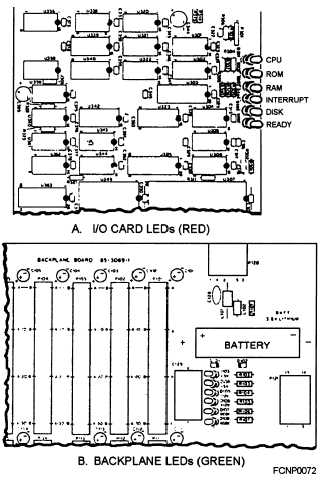The ROM-based diagnostics menu provides you
access to the following types of tests, again depending
on the type of computer and the system configuration:
disk read, keyboard, base memory, expansion memory,
printer, and power on.
Additional board mounted diagnostic
light-emitting diode (LED) indicators (fig. 8-24) are
normally provided on the computer backplane and I/O
logic circuit modules. This simplifies the diagnostic
software and aids in fault isolation and identification.
The LEDs on the backplane/motherboard for power
remain on as long as the microcomputer is on. The
LEDs on the I/O pcb extinguish as each test is
successfully completed, except the READY LED. It
will extinguish after an operating system is read from
disk.
The features of ROM-based diagnostics of micros
differ based on manufacturer and system configuration.
They are normally designed to provide at least 90%
Figure 8-24.—Examples of LED indicators.
resolution on detected faults to a single large scale
integration (LSI) circuit or supporting integrated
circuits. RAM and ROM errors are usually identifiable
to the specific IC chip. The ROM-based diagnostics are
designed to verify and fault isolate enough of the
computer’s logic to allow for loading and executing
more comprehensive diagnostic programs stored on
disk (floppy or hard disks).
EXECUTE BOOTSTRAP. —Micros are
normally designed to boot or initially load the disk
operating system (DOS) program from either the
installed floppy or hard disk assemblies, based on the
system configuration. The operating system program
provides for operator control of the loading and
executing of application programs used within the
microcomputer system.
There are two ways to boot a micro. Firmware
stored in PROM or ROM will automatically reference
the configured disk for the operating system program
as part of the power on sequence. Turn the micro ON
and it automatically looks for the operating system
program on the configured disk. If it finds it, the
operating system automatically loads. If it does not find
it, you will need to ensure the disks are setup correctly
and depress a combination of keys to cause the system
to boot.
INITIATE OPERATIONAL PROGRAMS. —
For microcomputers, once the microcomputer has been
booted, how the computer is configured will dictate
how to initiate the operational program, the software, to
be used.
EXECUTE AUTO RESTART OPERA-
TIONS. —There is also a particular combination of
keyboard keys (such as Ctrl, Alt, and Del) that will
cause the operating system program to reboot and
restart. This can be used in the event of a software
failure. You can also reboot by turning the computer
OFF and then ON.
EXECUTE DIAGNOSTICS. —YOU can load and
execute disk based diagnostics using DOS command
structures or a diagnostic monitor program. To execute
these, you usually load the programs by a different
power-up and boot sequence. The diagnostic monitor
program displays a test selection menu similar to the
internal diagnostic menu. Because these diagnostics
are more comprehensive than the ROM-based
diagnostics, you will be given more information on the
menu than you are with the ROM driven display. The
test selection menu provides for diagnostic selection,
test status, and error indications. The selection, test
8-19



